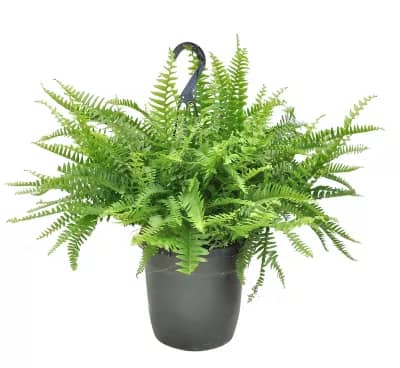Guide to Boston Fern: Care, Benefits, and FAQs
The Boston Fern (Nephrolepis exaltata) is a popular houseplant known for its lush, feathery fronds and easy-care nature. This fern adds a touch of greenery and elegance to any indoor space, making it a favorite among plant enthusiasts. In this article, we’ll explore everything you need to know about this plant, from its description and care tips to its benefits and frequently asked questions.
Description
It is a classic houseplant with a rich history. It features long, arching fronds that can grow up to 3 feet long, with each frond composed of numerous small leaflets. The plant’s vibrant green foliage is soft to the touch and creates a graceful, cascading effect. Native to tropical regions, Boston Ferns thrive in humid environments and indirect light.
How to Plant Boston Fern
- Choose the Right Pot: Select a pot with drainage holes to prevent waterlogging.
- Use Quality Soil: A peat-based potting mix or a mixture of peat and perlite works best.
- Planting Depth: Place the fern’s root ball at the same level it was in its previous container.
- Watering: Keep the soil consistently moist but not soggy. Water when the top inch of soil feels dry.
- Placement: Position the fern in a location with bright, indirect light. Avoid direct sunlight, which can scorch the fronds.

How to Care for Boston Fern
Humidity: This plant thrive in high humidity. Mist the fronds regularly or place a humidifier nearby.
Temperature: Keep the plant in a room with temperatures between 60-75°F (15-24°C).
Feeding: Fertilize monthly during the growing season (spring and summer) with a balanced, water-soluble fertilizer.
Pruning: Trim dead or yellowing fronds to encourage new growth.
Repotting: Repot every 2-3 years or when the
original container. Cover the roots lightly with soil.
Water Thoroughly: After planting, water the fern thoroughly to settle the soil around the roots.
How to Care for Boston Fern
Light: Place your plant in bright, indirect light. Avoid direct sunlight, which can scorch the leaves.
Watering: Keep the soil consistently moist, but not waterlogged. Water when the top inch of soil feels dry.
Humidity: This plant love humidity. Mist the fronds regularly or place a humidifier nearby, especially in dry indoor environments.
Temperature: Ideal temperatures range between 60-75°F (16-24°C). Avoid cold drafts and sudden temperature changes.
Fertilizing: Feed your fern with a balanced, water-soluble fertilizer every 4-6 weeks during the growing season (spring and summer).
Pruning: Trim off dead or yellowing fronds to encourage new growth and maintain the plant’s appearance.
Repotting: Repot your plant every 2-3 years to refresh the soil and provide more room for growth.
Benefits of Boston Fern …….
Air Purification: These plants are known for their air-purifying qualities, removing toxins like formaldehyde, xylene, and toluene from the air.
Humidity Boost: They add moisture to the air, which can be beneficial in dry indoor environments.
Aesthetic Appeal: Their lush, green fronds add a touch of natural beauty to any space, enhancing interior décor.
Stress Reduction: Indoor plants like the Boston Fern have been shown to reduce stress and improve overall well-being.
Bonus Tips:
- Propagation: Boston ferns can be propagated through division. Divide the root ball into smaller sections and pot them separately.
- Decorating: Boston ferns make excellent hanging plants. Use a decorative pot and place it in a location where the fronds can cascade naturally.
FAQs ……
Q: How often should I water ? : Water your plant when the top inch of soil feels dry. This typically means watering once a week, but frequency can vary depending on your home’s humidity and temperature.
Q: Can I grow a Boston Fern outdoors? : Yes, This plant can be grown outdoors in shaded or partially shaded areas in climates that are warm and humid. They are not frost-tolerant, so bring them indoors if temperatures drop below 50°F (10°C).
Q: Why are the fronds of my Boston Fern turning yellow? : Yellowing fronds can indicate overwatering, underwatering, or insufficient humidity. Ensure you are maintaining consistent moisture levels and providing enough humidity.
Q: How do I increase humidity for my Boston Fern? : You can increase humidity by misting the fronds regularly, placing a humidifier nearby, or setting the pot on a tray filled with water and pebbles (ensuring the pot is above the water level).
Q: Do Boston Ferns require a lot of sunlight? : This plant prefer bright, indirect light. Direct sunlight can cause the fronds to scorch, so place them near a window with filtered light or in a well-lit room.
Q: Can I propagate my Boston Fern? : Yes, This plant can be propagated by division. Carefully separate the root ball into smaller sections, ensuring each section has healthy roots and fronds, then replant them in fresh soil.
Q: What type of soil is best for Boston Ferns? : A well-draining, peat-based potting mix is ideal for plant . You can also use a mix of peat and perlite to ensure good drainage and aeration.
Q: Are Boston Ferns safe for pets? : Yes, These plants are non-toxic to cats and dogs, making them a pet-friendly houseplant option.

